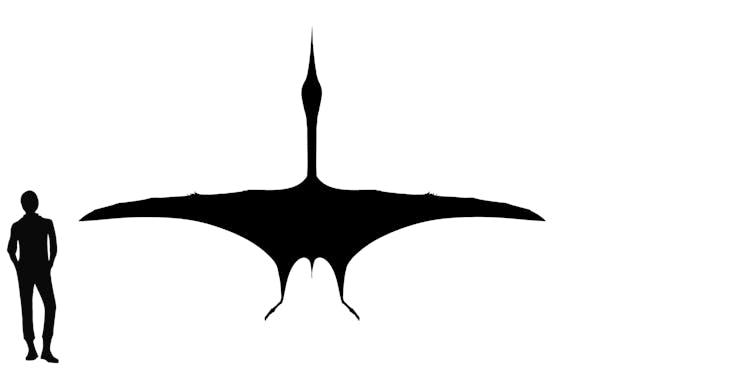


In 2003 Xabier Pereda Superbiola and colleagues named a new azhdarchid, Phosphatodraco mauritanicus, from the Khouribga Phosphates of central Morocco. The original fossils are made up of five neck vertebrae in articulation, and in 2018, Nick Longrich and colleagues described an additional neck vertebra from this species. The name Phosphatodraco translates to “phosphate dragon,” referencing its discovery in phosphate mines. The species name doesn’t refer to the modern country of Mauritania, but several ancient kingdoms and Roman provinces called Mauritania or Mauretania which occupied northern coastal regions of modern Morocco and Algeria.
The original specimen consists of vertebrae from the rear half of the neck, preserved on a phosphate slab. The vertebrae are well preserved, but crushed and cracked because of their thin and delicate bone walls. The front-most vertebrae, cervical 5, is the longest at about 30 cm (12 inches), with each subsequent vertebrae decreasing in length. Cervical 5 long, narrow, and roughly burrito-shaped with a width no greater than 7 cm (2.75 inches) and a height no greater than 3 cm (1.25 inches). Although the neural arch is present, there is no sign of any neural spine on this vertebrae, and the zygopophyses are short and horn-like.
Cervicals 6 and 7 are similar to cervical 5, but decrease in length at 22.5 and 19 cm (9 and 7.5 inches) respectively. The 8th cervical is shorter still, at 15 cm (6 inches), but unlike the others it has a prominent neural spine. The neural spine is above the rear part of the neural arch, rises about 3 cm above the top of the vertebra and is perpendicular to its long axis with a rectangular profile. The 9th cervical is only visible from its rear end, so it is impossible to measure its length.
The vertebra described by Longrich and colleagues was found alone, but is quite similar to the 6th cervical from the original specimen, and came from an individual of about the same size. No other remains of Phosphatodraco have so far been described, but comparisons to other azhdarchids show that its wingspan was probably about 5 meters (16.5 feet).
Azhdarchids were medium- to large-sized pterosaurs found in Upper Cretaceous rocks all over the world. The all have large heads with long toothless beaks, long necks, relatively short wings and long legs. They are thought to be terrestrial predators of small animals much like living shoebills and marabou storks. It’s also possible they waded in shallow water going after fish and near-shore invertebrates much like living herons.
The phosphate beds where Phosphatodraco was discovered were formed under relatively deep water off the coast of the African mainland in the final one million years of the Mesozoic. In addition to Phosphatodraco, two other unnamed azhdarchids were discovered at the mines, as well as one pteranodontid and three nyctosaurids. While pteranodontids and nyctosaurids were aerial fishers, azhdarchids like Phosphatodraco were not, and the azhdarchid specimens found in the mines likely died in flight, or were washed out to sea after death. The nearby mainland was arid and mountainous, a lot like coastal areas of modern Yemen and Oman.
